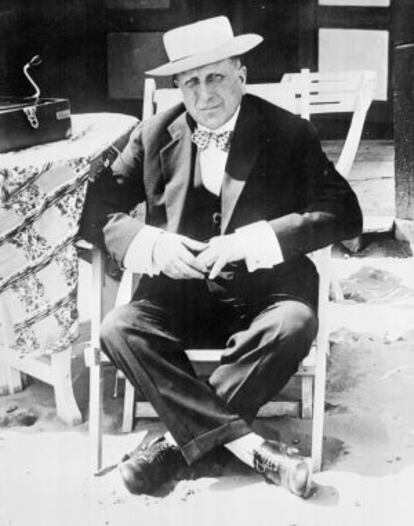"We want you to restore our garden cloister"
Owners' secrecy adds to mystery of origins of the cloister at Mas del Vent


In 2000, while she was working on the cathedral of Girona, a restorer specializing in stone façades named Lucrecia Ruiz-Villar was tasked with one of the most surprising jobs of her entire career: to produce a report on "how to restore a Romanesque cloister" located some 50 kilometers away.
When she entered the Mas del Vent property in the company of a representative of the owners, Ruiz-Villar was taken aback by the structure, surrounded by pine trees and next to an outdoor swimming pool. "Where does it come from?" she asked. But she received no answer.
What EL PAÍS has managed to piece together so far is that an antiques dealer named Ignacio Martínez Martínez bought the stones in 1931, and had it rebuilt double-quick in Madrid. "They wanted to put it together quickly to sell it to the Americans," Julián Ortiz recalls his father, the restorer Juan Manuel, saying. Martínez, of whom little is now known, had wealthy contacts in the leafy Arturo Soria district of the capital. One of these contacts was Arthur Byne, a photographer and draftsman from Philadelphia, who had an excellent reputation in Spain and was decorated by King Alfonso XIII in 1927 for services to Spanish culture.
But beneath this façade of honorability, Byne was a less than scrupulous dealer himself, selling all the Spanish heritage he could lay his hands on - especially to the press magnate William Randolph Hearst. Going by the purchases that Hearst made via Byne - Segovia's Sacramenia monastery (1925), the grille from Valladolid's cathedral (1929) parts of Benavente castle (1930) and scores more valuable antiquities - it seems quite possible that the newspaper baron was the intended buyer of the mysterious cloister. Hearst would end up buying nine such Romanesque jewels, but not the one that ended up by the sea in Girona province.
Ruiz-Villar recalls spending the entire morning exploring the cloister, and was told specifically not to take any pictures while the representative never left her side. "I had to convince him that photos were essential for the report," she says. According to this specialist, the worst pathology affecting the cloister was the salt accumulating in the sandstone and calcarenite stone, which had worn out its outer face.
"When it liquefies due to moisture, it makes the surface sandy and drags away much of the stonework. It might also have been brushed at one point, and lost a couple of layers," she says. Another problem she observed was "the large amount of liquid cement dribbles staining the stone, likely from 1959 when the stones were mounted."
The press magnate W. R. Hearst may have been the intended purchaser
Her advice was to remove the salt from the stone, eliminate the cement stains, seal the joints between the stones and place a surface over the structure to protect it from water.
"I'm no historian, but I've got 30 years experience in restoration work. And I have to say that if the cloister is a copy... it is a magnificent copy. The type of degradation I saw is very difficult to achieve artificially. The alterations are centuries old."
Ruiz-Villar was surprised to hear that the owners questioned the authenticity of their cloister. "They literally told me, 'We want you to restore a Romanesque cloister.' And it certainly struck me as being authentic."
In the end, after turning in her report, she never heard back from them again. But she was not surprised to see in the media that the cloister had indeed been restored after all.
Tu suscripción se está usando en otro dispositivo
¿Quieres añadir otro usuario a tu suscripción?
Si continúas leyendo en este dispositivo, no se podrá leer en el otro.
FlechaTu suscripción se está usando en otro dispositivo y solo puedes acceder a EL PAÍS desde un dispositivo a la vez.
Si quieres compartir tu cuenta, cambia tu suscripción a la modalidad Premium, así podrás añadir otro usuario. Cada uno accederá con su propia cuenta de email, lo que os permitirá personalizar vuestra experiencia en EL PAÍS.
¿Tienes una suscripción de empresa? Accede aquí para contratar más cuentas.
En el caso de no saber quién está usando tu cuenta, te recomendamos cambiar tu contraseña aquí.
Si decides continuar compartiendo tu cuenta, este mensaje se mostrará en tu dispositivo y en el de la otra persona que está usando tu cuenta de forma indefinida, afectando a tu experiencia de lectura. Puedes consultar aquí los términos y condiciones de la suscripción digital.
Últimas noticias
The brief rise and retreat of Generation Z in Mexico
From safe-haven investment to geostrategic weapon: Who owns the most gold and where are the bars kept?
Todd Green, head of the company that created ‘Candy Crush’: ‘Success for us is that players want to play for years’
Prices soar and Venezuela’s economy struggles under Trump’s pressure: ‘People are living day to day’
Most viewed
- Why we lost the habit of sleeping in two segments and how that changed our sense of time
- Trump’s obsession with putting his name on everything is unprecedented in the United States
- Charles Dubouloz, mountaineering star, retires at 36 with a farewell tour inspired by Walter Bonatti
- Venezuela faces its most tense Christmas yet
- The Florida Keys tourist paradise is besieged by immigration agents: ‘We’ve never seen anything like this’








































